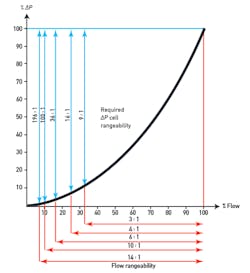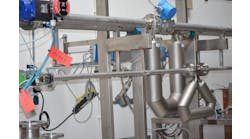In my May column, I described some new fiber-optic flowmeters used for subsea measurement of multiphase flows (oil, water, methane). Now I will describe some other, more recent advances in the field of flow instrumentation that have occurred partly because of the need for transporting and accurately metering large quantities of oil and natural gas.
Head-Type Flowmeters
When measuring flow by any differential pressure generating element, the measurement error is the sum of the sensor error, which is usually about one percent of actual flow (%AR), and the error of the d/p cell, which used to be around 0.25% to 0.5% of full scale (%FS). Therefore, in the past, if we wanted to keep the total error at minimum flow under 3%AR, the flow turndown (rangeability) had to be limited to about 4:1. Figure 1 shows the relationship between the turndowns in terms of flow and the corresponding turndown requirement of the ΔP transmitter.
Figure 1: At a ΔP turndown of 196:1, the flow turndown is 14:1, and at the minimum flow (100/14 = 7%), the total error is kept under 5%of actual flow (AR).
Today, the maximum turndown capability of a smart, digital ΔP transmitter is nearly 200:1. Because of the square root relationship, this means that the flow rangeability is 14:1 (142 = 196). With a ΔP measurement error of 0.065%FS, the d/p cell error is 12.74% AR at the minimum ΔP (196x 0.065 = 12.74%). Because of the square root relationship, this minimum ΔP error corresponds to a minimum flow error of √ 12.74% = 3.6%AR. Adding to this ΔP error, the 1%AR error of the sensor (the precision of its discharge coefficient CD), gives us a total error of only 4.6%AR at minimum flow. Naturally, the full 14:1 turndown can only be realized if at minimum flow (100/14 = 7% of full scale), the flow is still turbulent (RE > 8,000).
In addition to the tremendous increase in the accuracy of the state-of-the-art d/p cells, these smart units are provided with local displays, self diagnostics, alarms, memory boards for data acquisition and storage for hundreds of thousands of data points for displaying of trends, total flows, and to provide cell phone connectivity. They can be mounted to the sensor or connected wirelessly (IEEE802.11), allowing the sensor to be located in hard-to-access areas, while the d/p cell is in an easy-to-access location.
While the Venturi flowmeter is still the favorite when it comes to pressure recovery and accuracy, some of the other head-type flowmeter features also are competing on the hydrocarbon and other markets. For example:
- Conditioning orifice meters with wireless transmission (Figure 2);
- Regular and Venturi wedge meters for fluids containing sand or slurries;
- Averaging Pitot tube inside a flow nozzle combined with pressure/temperature sensors to calculate mass flow of natural gas;
- V-shaped cones. These cones require individual calibration, but their conditioning effect reduces the straight-run requirement; and
- Flow transmitters with pressure and temperature sensors can calculate mass flow of known molecular weight gases (Figure 3).
Playing in the hydrocarbon space
Figure 2: Wireless oriface flowmeters are appropriate for some hard-to-reach applications in oil-and-gas markets.
The temperature of flow
Figure 3: Flow transmitter with pressure and temperature sensors calculates mass flow of known molecular weight gases.
One should note that, in case of large flows, the unrecovered (permanent) pressure loss caused by the meter is an important consideration. This permanent loss is the worst in case of sharp restrictions (orifice ~ 70%) and the best with smooth transitions (Venturi ~ 15%), while something like the V-shaped cone causes an intermediate amount of permanent loss (~ 40%).
Other Flowmeter Types
[sidebar id="4"]
In addition to head-type flowmeters, intense activity in the hydrocarbon industry has catalyzed advances in other flowmeter families. In custody transfer applications, for example, the accurate and reliable Coriolis flowmeter is still the favorite, but other technologies are also competing for that market, for example, this bi-directional, multi-path, ultrasonic mass flowmeter for gas service (Figure 4). Similarly, at the drilling end of the hydrocarbon production process, a number of multiphase (oil, water, methane) flowmeters have been introduced, for example, the water cut meter, which uses five NIR wavelengths to distinguish water, oil and gas and the undersea multiphase flowmeter, which calculates the total flow and its oil, water and gas content by simultaneous measurements of variables. These units are designed for operation at some miles of depth under the ocean.







